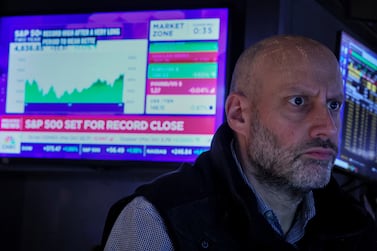A strong January for global stocks has not silenced doubters.
Higher-for-longer interest rates! Global economic malaise! Escalating regional wars! You know all the reasons bears say this bull market is definitively doomed, extending their 2023 arguments.
Wrong again. Markets move on what people do not widely know and watch – surprises, positive or negative.
This year, those surprises will be to the upside – shocking everyone again, like 2023.
My 2023 forecast foresaw a global bull market, inflation cooling, no deep global recession and technology and other growth stocks leading.
So it was. World stocks boomed 23.8 per cent. Technology soared by 53.3 per cent, powering America’s tech-heavy S&P 500 to rise by 26.3 per cent. Bonds rose broadly in a late surge.
Here is how I see 2024: Expect moderate double-digit gains for world stocks – as economic resilience and political tailwinds fuel a good to great year.
Tech and big growth should lead early before strength broadens mid-year in a value-led shift.
A sneaky truth about young bull markets: If they reach one year old – as this one did in October – they nearly always see a second birthday.
They are tougher to kill than anyone fathoms. Expect that.
Start with burgeoning global economic resilience. Despite fears, world gross domestic product grew in 2023.
US GDP accelerated for much of 2023 – to 4.9 per cent annualised in the third quarter and 3.3 per cent in the fourth quarter.
Full-year US GDP growth was 2.5 per cent, speeding from 2022 (the opposite of what many foresaw).
China’s 5.2 per cent full-year growth rejoined pre-Covid trendlines.
Eurozone recession? Did not happen – GDP was flat in the fourth quarter and grew by 0.2 per cent in 2023.
That is not gangbusters, but it easily tops countless deep downturn predictions.
Even tiny contractions such as Germany’s minus 0.3 per cent quarter on quarter in the fourth quarter are pre-priced and better than feared, as its stock market hitting record highs in December and again last month proves.
Inflation cooled big time. Despite December’s tiny rise, the world's largest economy's 3.4 per cent annual rate nears pre-coronavirus levels.
The US Federal Reserve’s targeted gauge – the headline personal consumption expenditures price index – annualised 1.99 per cent over the six months through to December, just under the Fed’s 2 per cent target.
Eurozone prices slowed drastically to 2.8 per cent annually in December, down from October 2022’s 10.6 per cent peak.
Inflation will irregularly keep easing, with western money supply growth ebbing.
Another bullish tailwind: Politics!
US politics turbocharged the rise of global stocks in 2023, as late-2022’s US mid-term elections cemented gridlock – sweet music to markets.
Now comes a US presidential election year, which will be strong for stocks.
Since reliable data started in 1925, US stocks climbed in 83.3 per cent of them, averaging 11.4 per cent gains in dollars.
Moreover, when stocks were negative in US presidents’ second years (like 2022), the subsequent fourth year (like 2024) was positive every single time since the Depression’s 1932 bottom – averaging 15.7 per cent returns.
I bet you did not know that.
Even better? Gridlock extends globally. In the UK, deep internal divisions and an election due by 2025 – probably happening sooner – keep the government from doing much.
Japan’s government is teetering over a financial scandal – also a recipe for little action.
Spain’s flimsy coalition government clings to life as internal divides over amnesty for Catalan pro-independence leaders threaten a new vote.
The Netherlands still has no government after November’s election – too gridlocked to form one.
Germany’s coalition bickers on budgets into inaction. France’s unpopular government faces more strikes and lacks political capital to pass anything big.
This global political landscape is endlessly noisy but largely devoid of big policy shifts. That extends the status quo worldwide – a reality stocks love.
Tech and other big global growth stocks should lead early in 2024 – tied to still-low growth rates. It is when their inherent growth power shines brightest.
Shop US tech and European luxury goods.
As resilient global economic growth becomes increasingly apparent later on and short-term interest rates start falling relative to long rates, value stocks should lead.
Why? Bank lending becomes more profitable, loosening lenders’ purse strings.
Marginal lending increases always help value businesses most, given their weaker balance sheets and volatile, economically sensitive earnings flows render them more bank loan-dependent.
They generally lack big growth companies' fat gross operating margins that fund self-financed growth.
So, then, make offensive value stocks such as banks, industrials and energy your targets. Their economic sensitivity primes them to outperform.
Downplay defensive sectors and industries such as utilities, health care and consumer staples. They are great in downturns, tied to steady demand. But not in adolescent bull markets with warming sentiment.
So, expect a bull market encore in 2024. Well-known, pre-priced worries cannot kill this young bull market.
Only a big, stealthy shock could. As I told you last month, none lurk now. Stay bullish – but nimble – in 2024.
Ken Fisher is the founder, executive chairman and co-chief investment officer of Fisher Investments, a global investment adviser with $200 billion of assets under management.










